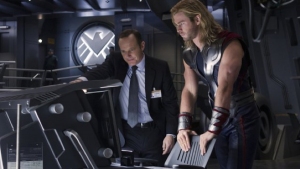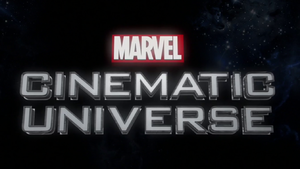One franchise that I believe takes transmedia storytelling and uses it to its advantage is Marvel. The Marvel Cinematic Universe (MCU) ranges from many feature films to television series to comic books and web series. The universe was created with 2008’s Iron Man and has been growing consistently ever since. In “Searching for the Origami Unicorn, Henry Jenkins describes The Matrix as “entertainment for the age of media convergence, integrating multiple texts to create a narrative so large that it cannot be contained within a single medium” (95), and I think the MCU acts in a very similar way.
According to it’s wikipedia page, the MCU is a shared universe centered on its films and based on the characters from Marvel comic books. The universe has now since expanded to not only films, but comic books, television and digital series (by this, I mean series on streaming services like Netflix and Hulu, as well as actual digital series online), and all contain cross overs (the wiki page’s example is the character Phil Coulson, played by Clark Gregg, appearing in all of the different media) (Wikipedia).
The films within the MCU are the central piece, and come in four phases (from their release dates). The first phase contains the movies Iron Man (2008) to The Avengers (2012). Phase 2 films are Iron Man 3 (2013) to Ant-Man (2015). Phase 3 films are Captain America: Civil War (2016) to an untitled Avengers film in 2019, and there are two films planned for Post-Phase 3. This does not even begin to include the television and web series of the MCU. However, from some light research online, you do NOT want to watch the films and television series in order by release date. No. For your viewing pleasure (and to not get confused) many websites have created their own timelines for how you should enjoy the MCU (here is one and another). I find this very fascinating because now that there is so much content about the MCU out there to watch, viewers can chose to enjoy it in chronological order so it can make more sense. In each film, television, and web series, more information about the MCU is given, and viewers are able to piece together what happens in the Universe by watching everything in the universe. You can, of course, chose not to watch a television show or a movie, but there will be some information missing. Jenkins describes this idea when talking about the Matrix, saying that the movie creators wanted “…to wind the story…across all of these media an have it all add up to one compelling whole” (101). The MCU does that with all of its media content on the big and small screens. From my understanding, the comic books that have come into this universe are official “tie-ins” that tell additional tales about the characters in the films and shows, and can tie them together. This is yet another media that the MCU has used to make its franchise more in depth and real to its viewers/readers.
Outside this “traditional” media, there are also video game tie-ins, Disney Park Attractions (which has acquired Marvel), and a collaboration with Coca-Cola for the 50th Super Bowl.
In Jenkins’ essay, he talks about the different aspects that help make up transmedia storytelling. Synergistic storytelling is telling story over several different installments and through different media that all connects together. The MCU does this well by including many crossovers in its films and television series, when characters from one film/show will show up in the storyline of another. Collaborative Authorship is very important to large transmedia projects. In the case of the MCU, there are many different producers/writers/directors/actors that are all a part of this Universe and must all collaborate to tell the universe’s story and make sure that storylines make sense. Just thinking about all of that planning makes my head hurt, but the MCU (from what I know) does a good job of tying everything they do together.The MCU employs the Art of World-Making (113) very well throughout the Universe. They have created a space for all of its characters, their backstories, and how they work together. Phil Coulson (played by Clark Gregg) shows up in all of the different media as the same character, and his recurrences throughout the Universe help it to be more cohesive and make senes to the viewers.

There has been so much created for this Universe in the past ten years that it will take a while to catch up. Don’t worry though, you have timelines to guide you through everything!
Word Count: 732
Works Cited:
Jenkins, Henry. Searching for the Origami Unicorn: The Matrix and Transmedia Storytelling . drive.google.com/file/d/1YyRvp3wvhMQ3st0BhpPim6edaTotciCz/view.
“Marvel Cinematic Universe.” Wikipedia, Wikimedia Foundation, 29 Mar. 2018, en.wikipedia.org/wiki/Marvel_Cinematic_Universe.
